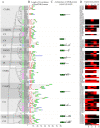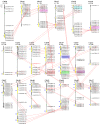Genome-wide analysis of the MYB transcription factor superfamily in soybean
- PMID: 22776508
- PMCID: PMC3462118
- DOI: 10.1186/1471-2229-12-106
Genome-wide analysis of the MYB transcription factor superfamily in soybean
Abstract
Background: The MYB superfamily constitutes one of the most abundant groups of transcription factors described in plants. Nevertheless, their functions appear to be highly diverse and remain rather unclear. To date, no genome-wide characterization of this gene family has been conducted in a legume species. Here we report the first genome-wide analysis of the whole MYB superfamily in a legume species, soybean (Glycine max), including the gene structures, phylogeny, chromosome locations, conserved motifs, and expression patterns, as well as a comparative genomic analysis with Arabidopsis.
Results: A total of 244 R2R3-MYB genes were identified and further classified into 48 subfamilies based on a phylogenetic comparative analysis with their putative orthologs, showed both gene loss and duplication events. The phylogenetic analysis showed that most characterized MYB genes with similar functions are clustered in the same subfamily, together with the identification of orthologs by synteny analysis, functional conservation among subgroups of MYB genes was strongly indicated. The phylogenetic relationships of each subgroup of MYB genes were well supported by the highly conserved intron/exon structures and motifs outside the MYB domain. Synonymous nucleotide substitution (dN/dS) analysis showed that the soybean MYB DNA-binding domain is under strong negative selection. The chromosome distribution pattern strongly indicated that genome-wide segmental and tandem duplication contribute to the expansion of soybean MYB genes. In addition, we found that ~ 4% of soybean R2R3-MYB genes had undergone alternative splicing events, producing a variety of transcripts from a single gene, which illustrated the extremely high complexity of transcriptome regulation. Comparative expression profile analysis of R2R3-MYB genes in soybean and Arabidopsis revealed that MYB genes play conserved and various roles in plants, which is indicative of a divergence in function.
Conclusions: In this study we identified the largest MYB gene family in plants known to date. Our findings indicate that members of this large gene family may be involved in different plant biological processes, some of which may be potentially involved in legume-specific nodulation. Our comparative genomics analysis provides a solid foundation for future functional dissection of this family gene.
Figures




Similar articles
-
Soybean (Glycine max) expansin gene superfamily origins: segmental and tandem duplication events followed by divergent selection among subfamilies.BMC Plant Biol. 2014 Apr 11;14:93. doi: 10.1186/1471-2229-14-93. BMC Plant Biol. 2014. PMID: 24720629 Free PMC article.
-
Soybean (Glycine max) SWEET gene family: insights through comparative genomics, transcriptome profiling and whole genome re-sequence analysis.BMC Genomics. 2015 Jul 11;16(1):520. doi: 10.1186/s12864-015-1730-y. BMC Genomics. 2015. PMID: 26162601 Free PMC article.
-
Genome-wide classification and expression analysis of MYB transcription factor families in rice and Arabidopsis.BMC Genomics. 2012 Oct 10;13:544. doi: 10.1186/1471-2164-13-544. BMC Genomics. 2012. PMID: 23050870 Free PMC article.
-
Characteristics and Functions of MYB (v-Myb avivan myoblastsis virus oncogene homolog)-Related Genes in Arabidopsis thaliana.Genes (Basel). 2023 Oct 31;14(11):2026. doi: 10.3390/genes14112026. Genes (Basel). 2023. PMID: 38002969 Free PMC article. Review.
-
Current topics in genome evolution: molecular mechanisms of new gene formation.Cell Mol Life Sci. 2007 Mar;64(5):542-54. doi: 10.1007/s00018-006-6453-4. Cell Mol Life Sci. 2007. PMID: 17192808 Free PMC article. Review.
Cited by
-
Dissecting the Genome-Wide Evolution and Function of R2R3-MYB Transcription Factor Family in Rosa chinensis.Genes (Basel). 2019 Oct 18;10(10):823. doi: 10.3390/genes10100823. Genes (Basel). 2019. PMID: 31635348 Free PMC article.
-
Genome-Wide Identification and Expression Analysis of the R2R3-MYB Transcription Factor Family Revealed Their Potential Roles in the Flowering Process in Longan (Dimocarpus longan).Front Plant Sci. 2022 Mar 25;13:820439. doi: 10.3389/fpls.2022.820439. eCollection 2022. Front Plant Sci. 2022. PMID: 35401601 Free PMC article.
-
GmMYB181, a Soybean R2R3-MYB Protein, Increases Branch Number in Transgenic Arabidopsis.Front Plant Sci. 2018 Jul 17;9:1027. doi: 10.3389/fpls.2018.01027. eCollection 2018. Front Plant Sci. 2018. PMID: 30065741 Free PMC article.
-
In Silico Genome-Wide Analysis of the ATP-Binding Cassette Transporter Gene Family in Soybean (Glycine max L.) and Their Expression Profiling.Biomed Res Int. 2019 Jan 10;2019:8150523. doi: 10.1155/2019/8150523. eCollection 2019. Biomed Res Int. 2019. PMID: 30766888 Free PMC article.
-
Evolution and functional diversification of R2R3-MYB transcription factors in plants.Hortic Res. 2022 Mar 8;9:uhac058. doi: 10.1093/hr/uhac058. eCollection 2022. Hortic Res. 2022. PMID: 35591925 Free PMC article.
References
-
- Riechmann JL, Heard J, Martin G, Reuber L, Jiang C, Keddie J, Adam L, Pineda O, Ratcliffe OJ, Samaha RR, Creelman R, Pilgrim M, Broun P, Zhang JZ, Ghandehari D, Sherman BK, Yu G. Arabidopsis transcription factors: genome–wide comparative analysis among eukaryotes. Science. 2000;290:2105–2110. doi: 10.1126/science.290.5499.2105. - DOI - PubMed
-
- Amoutzias GD, Veron AS, Weiner J 3rd, Robinson-Rechavi M, Bornberg-Bauer E, Oliver SG, Robertson DL. One billion years of bZIP transcription factor evolution: conservation and change in dimerization and DNA-binding site specificity. Mol Biol Evol. 2007;24:827–835. - PubMed
-
- Lipsick JS. One billion years of Myb. Oncogene. 1996;13:223–235. - PubMed
-
- Stracke R, Werber M, Weisshaar B. The R2R3–MYB gene family in Arabidopsis thaliana. Curr Opin Plant Bio. 2001;l4:447–456. - PubMed
Publication types
MeSH terms
Substances
LinkOut - more resources
Full Text Sources
Other Literature Sources

